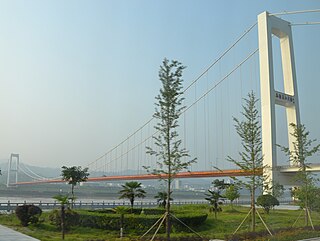Rediscovering the Yangtze River (Chinese :再说长江; pinyin :zàishuō chángjiāng) is a 2006 documentary created by China Central Television to follow up on an earlier 1984 documentary film named "The Story of the Yangtze River" (Chinese :话说长江; pinyin :huàshuō chángjiāng).

Chinese is a group of related, but in many cases not mutually intelligible, language varieties, forming the Sinitic branch of the Sino-Tibetan language family. Chinese is spoken by the ethnic Chinese majority and many minority ethnic groups in China. About 1.2 billion people speak some form of Chinese as their first language.
Hanyu Pinyin, often abbreviated to pinyin, is the official romanization system for Standard Chinese in mainland China and to some extent in Taiwan. It is often used to teach Standard Mandarin Chinese, which is normally written using Chinese characters. The system includes four diacritics denoting tones. Pinyin without tone marks is used to spell Chinese names and words in languages written with the Latin alphabet, and also in certain computer input methods to enter Chinese characters.

China Central Television is the predominant state television broadcaster in Mainland China. CCTV has a network of 50 channels broadcasting different programmes and is accessible to more than one billion viewers. As of present, there are 50 television channels, and the broadcaster provides programming in six different languages. Most of its programmes are a mixture of news, documentary, social education, comedy, entertainment, and drama, the majority of which consists of Chinese soap operas and entertainment.
It is China's first documentary shot entirely in 1080i HDTV. Filming began in 2004 and the first episode aired in July 2006. The series has a total of 33 episodes with a run time of 30 minutes per episode. An English version has also aired on CCTV's International English channel in July 2007. Both the Chinese and English versions are now available online in low resolution. [1] [2]
1080i is an abbreviation referring to a combination of frame resolution and scan type, used in high-definition television (HDTV) and high-definition video. The number "1080" refers to the number of horizontal lines on the screen. The "i" is an abbreviation for "interlaced"; this indicates that only the odd lines, then the even lines of each frame are drawn alternately, so that only half the number of actual image frames are used to produce video. A related display resolution is 1080p, which also has 1080 lines of resolution; the "p" refers to progressive scan, which indicates that the lines of resolution for each frame are "drawn" in on the screen sequence.
The series is being aired on TVB Jade and TVB High Definition Jade under a Cantonese dub.
TVB Jade, or simply Jade, is a Hong Kong Cantonese-language free-to-air television channel owned and operated by Television Broadcasts Limited (TVB) as its flagship service, alongside its sister network, the English-language TVB Pearl. Broadcasting started on Nov 19, 1967. It is headquartered at TVB City at the Tseung Kwan O Industrial Estate in Tseung Kwan O, in the Sai Kung District. Primarily broadcasting entertainment programming, TVB Jade has historically been the most dominant television channel in the region in terms of viewership, with its closest competitor having been the now-defunct ATV Home.

Cantonese is a variety of Chinese spoken in the city of Guangzhou and its surrounding area in Southeastern China. It is the traditional prestige variety and standard form of Yue Chinese, one of the major subgroups of Chinese.













